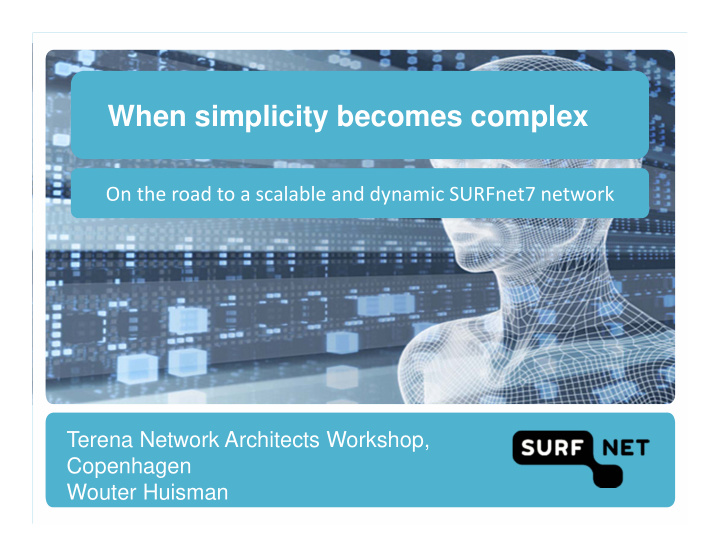



When simplicity becomes complex On the road to a scalable and dynamic SURFnet7 network Terena Network Architects Workshop, Copenhagen Wouter Huisman
What do we want from a network? • Scalable • Flexible • Cost efficient • Endusers service requirements • Bottomline is keep it simple
SURFnet6 network Hamburg Münster Aachen 3 Geneva (CERN)
Collapsed I P core Border Routers Located in Ams1 and Ams2 SURFnet AS1 1 0 3 Core Routers Customer SURFnet – SNE masters BGP in de praktijk
Transport layer
Inter Domain NSI BoD in SURFnet6 Application NSI User NOC engineer
What to optimize of SURFnet6? And make SURFnet7 simple…
SURFnet7 : Scalable netw ork I nstitute I nstitute Routed I P ✔ 2008 ( Layer 3 ) Application Application Application Application Application Application Next Generation Ethernet Service Service ( Layer 2 ) ✔ 2010 Bandw idth Bandw idth Optisch Transport ( Layer 0 / 1 ) 8
Concepts in the SURFnet7 tender • Single technology end-2-end transport • Remove as many OEO as possible • Be ready for 40G and 100G • Improve the BoD solution • Selected Ciena CES solution – 5410, 3930, 5150 – Based on PBB-TE
Tiered Network Architecture
Tiered Network Architecture
Tiered Network Architecture
Tiered Network Architecture
Tiered Network Architecture
Tunable XFP & OTN XFP 5410 ‐ CES CPL – DWDM OADM • No transponder shelves required • Tunable DWDM XFP used Transponder • Save on power, footprint, OAM • ~25% of the links require G.709
Scalability issue • Uptake lightpath services was significant • Technology limitation • Bandwidth claimed for 100%, even though not all used. • Single service per port
Statistical Multiplexing EIR CIR a a b a,b,c b a c b c c 17
One or more services on a single port • Single Service Port (SSP) - One service, one port • Multi Service Port (MSP) - Multiple network services, one port - Efficient use of interfaces 10 Gbit/s SURFinternet SURF-lightpath SURF-lightpath OnDemand lightpath Free MSP Interface 2 Gbit/s 1 Gbit/s 2 Gbit/s 3 Gbit/s 2 Gbit/s 18
BoD in SURFnet7 NOC engineer User Application Inter Domain NSI NSI GUI API Identity SURFnet7 BoD Provider MTOSI GUI SURFnet7 NMS Group Provider 19 19
xx 20
Can we manage elephant flows? • Unpredictability of the dynamic nature of BoD • BoD tend to generate large flows (> 1Gb/s) • Can we rely on the NMS?
BW enforcement for tunnels and services • Layered structure of tunnels and services • Each tunnel has a bandwidth profile • Services are added to tunnels as long as tunnel can accommodate Link capacity Tunnel profile Service BW
Tunnel CIR: 2 node network Future lightpaths A B Existing lightpaths Consider: • 10G Link between A and B • Filled with single tunnel and consuming 50% of CIR bandwidth • 5G SLP is to be reserved for new install • Tunnel profile is changed to claim 100% CIR bandwidth In mean time a DLP is reserved claim 1G bandwidth on the existing tunnel, and • consumes the bandwidth of the SLP service • End result: SLP can not claim its bandwidth on this link SLP: static lightpath DLP dynamic lightpath
Solution • DLP can only be transported across DLP tunnels • Claim Bandwidth in advance – Create dummy tunnels with required CIR for new services – Or increase the CIR bandwidth of existing SLP tunnels
2 elevator dilemma • Assume 2 elevators, both with capacity for exact 10 people
2 elevator dilemma • Assume 2 elevators, both with capacity for exact 10 people Drop at least 1 person and a guitar
LAG problem • Consider Lightpath flows of 6 Gb/s and of 5 Gb/s – A CES will autonomous decide, which LAG member to use – A LAG of 2 x 10G should be sufficient – But you have 50% chance on packet drop • Problem with LAGs with flows > 10% physical link speed
Solutions to the LAG issue • Use higher line rate instead of LAGs – Use 100G • Use LAGs, but be conscious not to put high bandwidth flows on a LAG as you are loosing control
NMS implements Strict & Loose CAC flag Strict CAC LAG • LAG with 1 member • Can accommodate any services Loose CAC LAG • LAG with possibly more link members • Accommodates Lightpaths upto 1Gb/s And IP
Conclusions • SURFnet7 has some clear optimizations – End-2-end single service layer for IP and lightpath – Tunable XFP – BoD uses the NMS DB and path computation – Statistical multiplexing – Multi Service Ports • Complications to secure BW guarantee – Large single data flows – Unpredictable network planning
wouter.huisman[at]surfnet.nl W www.surfnet.nl +31 30 2 305 305 Creative Commons “Attribution” license: http://creativecommons.org/licenses/by/3.0/
Recommend
More recommend